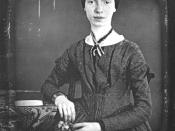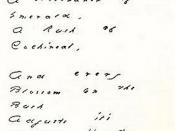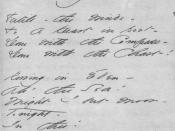Emily Dickinson
Emily Dickinson's poetry mostly reflects her feelings towards death and the projected events after death. As a poet, she was a very inward, and wrote about feelings that came from deeply within her--unlike other poets of her time whose societies were directly shown in their poetry (i.e.-Walt Whitman). Of course social and historical values shaped her personality, but in her poetry alone little can be derived about either the time period she lived in or the political and societal issues during her lifetime.
Emily Dickinson was a very unique poet for her time. Her poems were mostly written in four line stanzas that have the voice of a hymn or psalm. Her scheme was usually an ABCB rhyme scheme. Her poems have short pauses interjected by dashes, which interrupt the rhythm, typically done in iambic pentameter. One of her greatest assets is her ability to write about subjects that all audiences can relate to.
She introduces topics that will never be outdated because of changes in society, changes in politics, or changes in technology. She writes of spirituality and godliness, of death and afterlife, these subjects will never cease and therefore her poetry is immortal. It will survive years to come due to its revolutionary ideas and its universality.
In one of her poems, "I died for beauty, but was scarce", one can obviously see the theme of death and the ABCB rhyme scheme.
"I died for beauty, but was scarce
Adjusted in the tomb,
When one who died for truth was lain
In an adjoining room.
He questioned softly why I failed?
"For beauty," I replied.
"And I for truth,-- the two are one;
We brethren are," he said.
And so, as kinsmen met a night,
We talked between the rooms,
Until the moss had reached...


